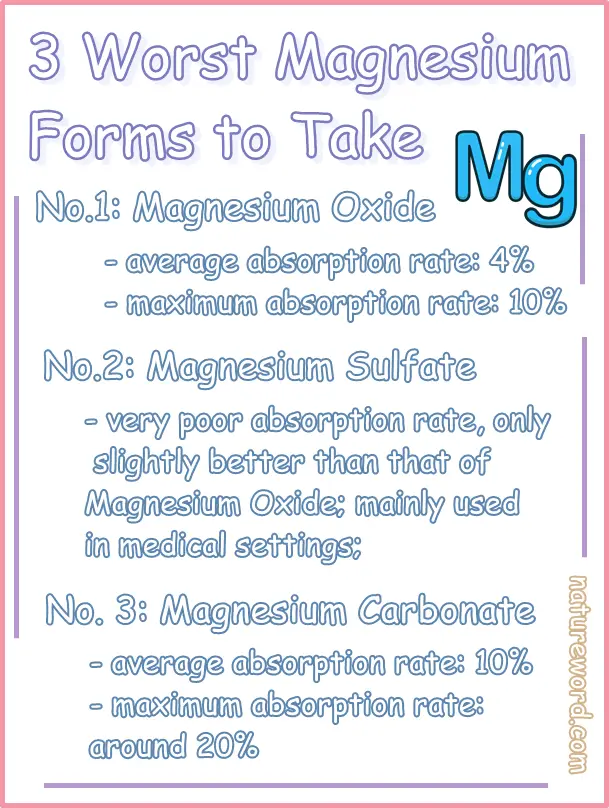Not all magnesium formulations in dietary supplements are the same. Some magnesium forms get absorbed well and some have a very poor absorption rate.
Not just this, but some formulations are better than others when it comes to specific uses.
Not to mention that magnesium supplements are not devoid of side effects and this is also something very important to take into consideration when choosing what magnesium to take.
Not all official sources agree with the proposed absorption rates of the different types of magnesium formulations, but it’s okay because they are consistent when it comes to the range of bioavailability which is enough.
People are different anyway, particularly in their degree of nutritional deficiencies, so not everybody will absorb the same magnesium formulation with the exact same efficacy.

But this means that there are, indeed, magnesium forms that are absorbed poorly, just as there are magnesium forms that are absorbed well.
While we only take in around 10% or 20% of most forms of magnesium, there are magnesium formulations with an absorption rate of 50% or 60%. Some forms of magnesium are absorbed even better, and some have an even worse bioavailability.
What are the worst magnesium forms?
1- Magnesium oxide
When it comes to absorption rate, magnesium oxide is the worst. Magnesium oxide is one of the most common formulations in dietary supplements and the form of magnesium most official sources agree is the worst to take.
Magnesium oxide is an inorganic type of magnesium, and inorganic formulations in general are absorbed more poorly compared to organic ones.
Magnesium oxide has an absorption rate of around 4%, but can go as high as 10% (best case scenario). To counteract this, dietary supplement producers use more magnesium in their products.
However, taking a large dose of a supplement won’t automatically ensure you absorb more. It’s actually quite the opposite: smaller doses throughout the day ensure you get more magnesium in your system overall.

Of course, if you have a severe magnesium deficiency and magnesium oxide is the only available option, whether because of financial reasons or simply because of the lack of availability of other options, then it’s the best form you can take.
The priority is to correct a deficiency (the more severe the deficiency, the more urgent the need to correct it!) – everything else falls second.
If you are taking magnesium oxide of all forms, it can help to split your dose into multiple smaller doses taken at regular intervals throughout the day to boost absorption.
Smaller doses will also help you better control and possibly also avoid the side effects associated with taking this particular formulation: in addition to having a poor bioavailability, magnesium oxide is known to cause loose stools and diarrhea, and general digestive upset. But taking smaller amounts can help you determine your upper limit.
Although not the best form for correcting a deficiency, magnesium oxide makes an excellent antacid.
The formulation is great for treating symptoms of acid reflux and indigestion. You can take magnesium oxide for regurgitation of stomach juices and associated heartburn, and for calming stomach upset. It works within a window frame of 15 to 20 minutes.
2- Magnesium sulfate
One of the worst forms of magnesium you can take is magnesium sulfate. While it’s more bioavailable than magnesium oxide, magnesium sulfate is still not one of the best forms of magnesium to take because of its overall low absorption rate in OTC dietary supplement formulations.
Magnesium sulfate is an inorganic form and inorganic formulations have a poorer absorption rate from the start, albeit higher than the absorption rate of magnesium oxide.
See what is the best absorbed magnesium form between organic and inorganic formulations.
While it’s not the best form of magnesium to consider in OTC dietary supplements, magnesium sulfate is used successfully in medical settings for potentially life-threatening conditions such as pre-eclampsia and eclampsia, but also forms of arrhythmia with high risks of sudden cardiac arrest and death.
Excessive intakes can lower blood pressure to abnormal levels. A too large a dose can lower levels of calcium in the blood which has potentially life-threatening implications for health. Symptoms such as nausea and vomiting, muscle weakness, decreased heart rate and breathing, fainting sensation and arrhythmias require medical attention.
3- Magnesium carbonate
Magnesium carbonate is one of the more common magnesium formulations available as dietary supplements.
Its main uses include correcting a magnesium deficiency and improving associated side effects such as painful muscle cramps, but also arrhythmias and even low mood.
Magnesium carbonate is better absorbed than both magnesium oxide and sulfate, however, being an inorganic form, it has reduced bioavailability compared to many other formulations, including magnesium citrate, aspartate, lactate, malate and gluconate.
If we were to compare magnesium carbonate vs magnesium citrate, two of the most common formulations on the market, magnesium carbonate has a 10% and to up to 20% lower absorption rate than citrate.
The absorption rate for magnesium carbonate is 10% to 20% at best. In some instances, the carbonate form has been found to have a maximum absorption rate of less than 10%.
Conclusion
While any magnesium form will do if the body’s demand for the mineral is severe, and side effects are generally mild if intake is regulated, absorption rate is a factor to absolutely consider when looking at what magnesium form to choose. The amount of magnesium you absorb from dietary supplements ultimately determines how many benefits you are getting from supplementation and can make a big difference in your quality of life.

